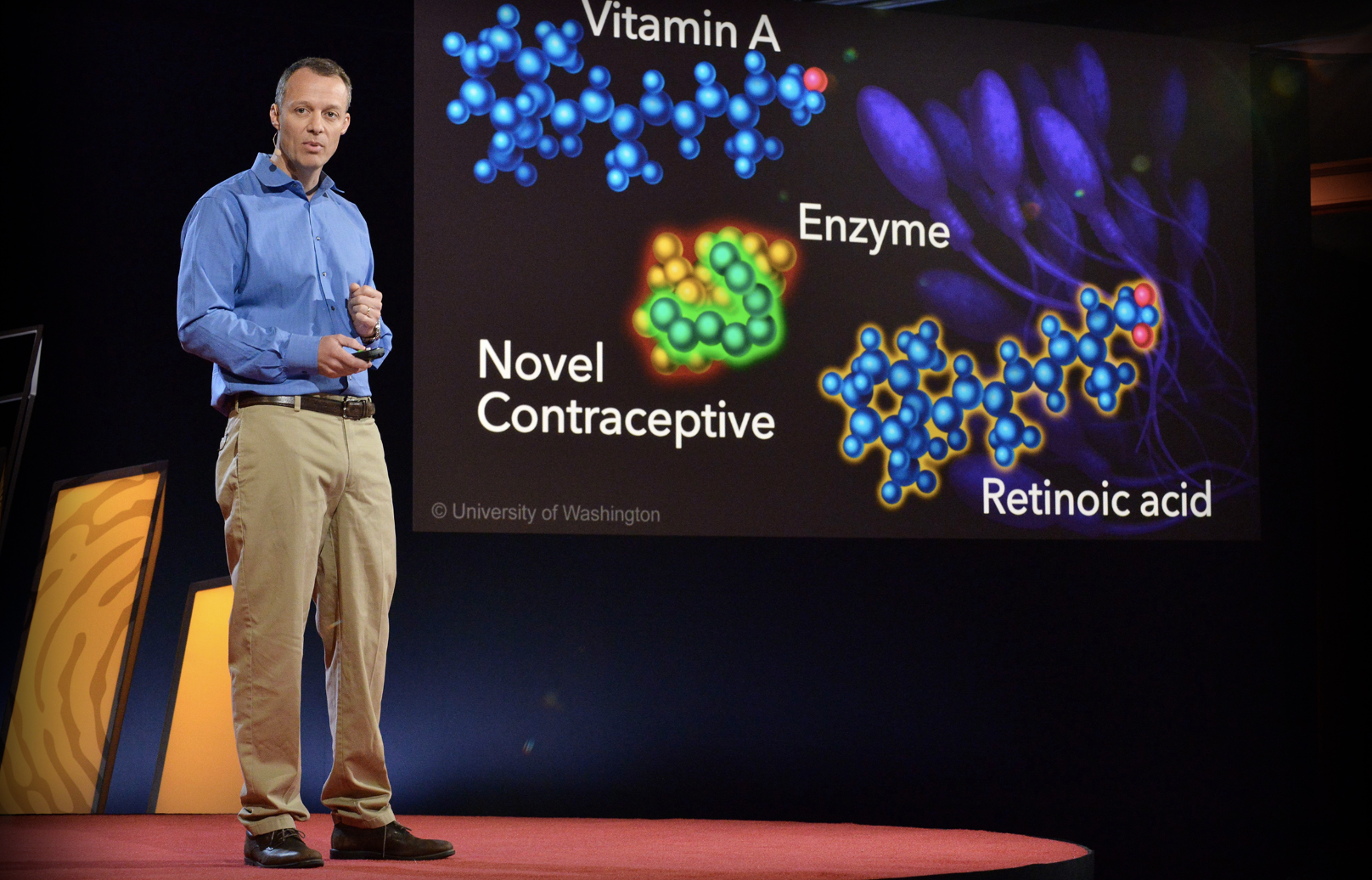こんにちわ。
TEDの動画より医療英会話の学習に有用なスピーチを紹介します。
今回のテーマは男性避妊用ピルに関する内容です。
男性避妊用ピルに関しては、2019年3月25日にクリスティーナ・ワング共同主任が率いる研究チームが臨床試験で安全性が確認できたと発表した事で話題になりました。
当時発表された内容としては「11-beta-MNTDC」と呼ばれる男性避妊用の経口避妊薬は男性の2つのホルモンの働きに作用し、精子形成を抑制しつつ、性欲を保つ効果があるというものでした。
さて、今回講演するのはジョン・アモリーさんです。
彼は現在、ワシントン大学の医学教授および一般内科部門長として、入院病棟および外来一般内科および男性の健康クリニックの主治医として働いています。
更に彼は現在、精巣レチノイン酸生合成の阻害剤を可逆的男性避妊薬として使用する可能性の研究をされています。
また、男性生殖の分野で130以上の査読付き論文を発表しており、男性避妊イニシアチブの諮問委員会の委員を務めています。
それでは早速TEDで学習をしていきましょう。
TEDで医療英会話を学習【John Amory|男性用避妊ピルをいかに作用させるか】
英語-日本語訳全文
00:04
When I tell people that I'm trying to develop a contraceptive pill for men, the response usually varies along gender lines.
私が男性用避妊ピルの開発をしていると言うと、性別により反応は違います。
Women say something like, "Fantastic. It's about time. When?" (Laughter)
女性は「素晴らしいわね。いつなの?」この様に言ってくれます。(笑)
00:21
Men have one of two responses.
男性は2つのパターンに分かれます。
They either love the idea, or they look at me a little warily and wonder what exactly I have in store for their testicles.
(Laughter)
このアイデアを喜んでくれる方もいれば、私の話を少し用心して聞き、何が自分に待ち受けているのかを疑問に思う方もいます。(笑)
00:33
So why does the world need a male pill?
では、世界はなぜ男性用ピルを必要としているのでしょうか。
Well, what if I told you that of the six million pregnancies annually in the United States, three million of them are unintended? That's half. That's a really surprising number.
アメリカにおいて毎年600万件ある妊娠のうち、300万件が予想外の妊娠なのです。半分です。これは本当に驚くべき数字です。
And those three million unintended pregnancies account for the vast majority of the more than one million abortions annually performed in the United States.
そしてこの300万件の予想外の妊娠のほとんどが、年間100万件以上の中絶に繋がってしまっているのです。
Happily, the rate of unintended pregnancy has fallen in the last few years by about 10 percent.
幸運にも、ここ数年の予想外の妊娠率は約10%に減ってきています。
This is because more women are using effective, long-acting, reversible forms of contraception.
But we still have a long way to go.
これは一重に多くの女性が効果的で、長時間作用型の、可逆的な避妊法を用いているからです。
しかし、私たちの道のりはまだまだ遠いです。
01:16
One approach that's finally becoming a real possibility is better contraceptive options for men.
1つの手法がより良い男性向けの避妊法として現実になりつつあります。
Think about it. We have over a dozen methods of contraception for women: pills, patches, IUDs, shots, sponges, rings, etc.
考えてみて下さい。たくさんの女性向けの避妊法があります。ピル、パッチ、IUD、注射、スポンジ、リング等です。
For men, we've had the same two options for more than a hundred years: condoms and vasectomy.
男性向けには、100年以上にわたり2つの方法しかありません。コンドームと精管切除です。
Despite having only two options, both of which have significant drawbacks, men currently account for 30 percent of all contraceptive use, with 10 percent of couples relying on vasectomy and 20 percent of couples using condoms.
たった2つしか無いにもかかわらず、両方が重大な欠点を持っています。現在男性の内の30%が避妊していますが、その内10%のカップルは精管切除に、20%のカップルはコンドームに頼っています。
Why are 20 percent of couples relying on condoms for contraception when condoms have a one-year failure rate of over 15 percent?
何故年に15%を越える失敗率があるにもかかわらず、20%のカップルはコンドームを避妊法に用いるのでしょうか。
It's because many women can't either safely take currently available female contraceptives, for reasons such as blood clots, or they can't tolerate the side effects.
なぜならば、多くの女性が凝血や副作用の影響の恐れといった理由から安全に女性向けの避妊法を選択することが出来ないからです。
02:19
So if we think a male contraceptive would be useful, the next question is: How do we go about developing one?
もし男性向け避妊法が役に立つと思うならば、次の疑問はいかにしてその手段を開発していくか、という事になります。
Well, there's two general approaches.The first approach is to try and interfere with the way the sperm swim towards or bind to the egg.
2つの方法があります。1つ目の方法は、精子が卵子と結合、もしくは結合しようとする事を防ぐ方法です。
This approach turns out to be really difficult, because it's hard to get enough medication in the small volume of the ejaculate and have it still work inside the female reproductive tract.
これはとても難しいです。なぜならば、わずかな量の射精物に対して十分な薬物を得て、かつ女性器の中で作用効果を持続させる事はとても大変だからです。
This is why there's been a lot more work done on the second approach, which is turning off sperm production entirely.
そこで2つ目の方法として精子の生産を完全に絶ってしまう方法がよく用いられています。
This is also challenging. Why? Turns out that men make a lot of sperm. (Laughter)
これもまた挑戦的な事です。何故か?つまり、男性はたくさん精子を作るからです。(笑)
03:02
Men make a thousand sperm every second and to have an effective contraceptive, you need to get that level of sperm production down to one percent of its normal value.
男性は1秒あたりに1000個の精子を作っています。効果的に避妊するには、精子の製造を通常値の1%まで下げなければなりません。
The good news is, this is possible, almost.
こちらは、行うことが可能です。
The most studied approach has been to use hormones to suppress sperm production.
よく用いられるのはホルモンを用いて精子の生産を抑圧する方法です。
Testosterone and progesterone, when administered together, will suppress the signals from the brain to the testes to make sperm, and in about 90 percent of men, sperm production after three to four months will stop.
テストステロンとプロゲステロンは共に身体に与えることにより、精子製造の為の精巣への脳からの信号を抑えます。
90%の男性が3~4ヶ月後には精子の製造が止まります。
Unfortunately, 10 percent of men don't respond to these hormonal regimens for reasons that aren't understood.
ただ、不運なことに、原因不明でホルモン療法が効かない男性も10%程います。
03:46
For the last several years, my colleagues and I have been taking a different approach to male contraceptive development, one that doesn't involve the administration of hormones.
ここ数年、私と同僚はホルモン制御を用いない避妊法を開発してきました。
Specifically, we are looking to block the function of vitamin A in the testes.
特に、我々は精巣でのビタミンAの機能を妨げる試みを行っています。
Why? Well, for over 90 years it's been known that you need vitamin A to make sperm.
何故か?90年以上ビタミンAが精子の製造に必要であると知られている為です。
Animals who are deprived of vitamin A in their diet stop making sperm and restart making sperm again when the vitamin A is reintroduced.
ビタミンAが欠乏した食事を摂った動物は、精子の製造を中止し、ビタミンAが再投入されて初めて精子の製造を再開します。
The vitamin A that we ingest is converted by a family of enzymes to something called retinoic acid.
私達の摂取するビタミンAは酵素類をレチノイン酸に変えます。
One of these enzymes is found only in the testes. It's this enzyme that we are attempting to block.
酵素類の中の1つに精巣にしかない物が発見されました。
The blockade of this enzyme should deprive the testes of retinoic acid and stop sperm production without affecting vitamin A's functions elsewhere in the body.
これこそが我々がブロックしようとしている酵素です。酵素をブロックすることにより、精巣のレチノイン酸が奪われ、身体の他の部分にはビタミンAの影響を与えずに、精子の製造を止めることができます。
We're testing this approach in animals and hope to move to human testing soon.
既にこの方法を動物に対し行っており、すぐに人体に対しても行える様になることを望んでいます。
04:48
Obviously, the impact of such a male contraceptive would go well beyond reproductive biology.
明らかにこのような男性向け避妊法の影響は、生殖生物学の域を超えて順調に進んでいます。
It's interesting to speculate about the effect that it would have on relationships between men and women.
男性と女性の関係に及ぼしうる影響を推測する事はとても興味深いです。
One intriguing possibility is that a man could monitor his contraceptive status over time.
一つの面白い可能性として、男性が自身の避妊法の状態をずっと確認する事が出来るでしょう。
In the last several years, two groups have introduced home sperm-testing devices that are iPhone-based and that are easy to use.
近年、2つのグループが、iPhoneで簡単に用いることの出来る、家庭用精子検査装置を紹介しました。
A man could test his sperm count and share the result with his partner.
男性は自分の精子数を検査する事ができ、その結果をパートナーと共有出来ます。
If the man's sperm count were zero, the man and his partner would feel very comfortable relying on his contraceptive.
もし男性の精子数がゼロであれば、男性とそのパートナーは、彼の取った避妊法をとても快適に感じるでしょう。
A tool like this, coupled with a male contraceptive, could greatly increase the role for men in preventing unintended pregnancy.
この様なツールは、男性向け避妊法と相まって、男性の予想外の妊娠を防ぐ上での役割を増やすことでしょう。
The researchers who are working on male contraception are trying to create a better future for couples, a future where contraception is no longer considered just "a woman's issue," rather an issue for couples to decide together.
男性向け避妊法の研究者はカップルのより良い未来を創ろうとしています。そう、避妊がもはや単に「女性の問題」ではなく、むしろカップルが二人で共に決めていくものになる、そんな未来を。
05:52
So why does the world need a male pill? Well, I believe that a male pill will help reduce the stubbornly high rates of unintended pregnancy and abortion and allow men to equally participate in contraception.
世界は何故男性向け避妊ピルを必要とするのでしょうか?私は男性用ピルが未だ高いままの予想外の妊娠数、中絶を減らし、男性に平等な避妊への参加を助けるものだと信じています。ありがとうございました。
まとめ|今回のスピーチの内容
如何でしたでしょうか。
ジョン・アモリーはこの講演で、予想外の妊娠を防ぐ上で避妊において男性に新しい選択肢を与え、責任を持たせる革新的な男性用の避妊法を開発したと述べています。
更に開発中の技術と、何故世界が男性用避妊ピルを必要としているかについても述べています。
新しい薬剤開発と市場へ出回るためには更なる研究が必要ですが、産婦人科医としても非常に勉強になる内容でした。

